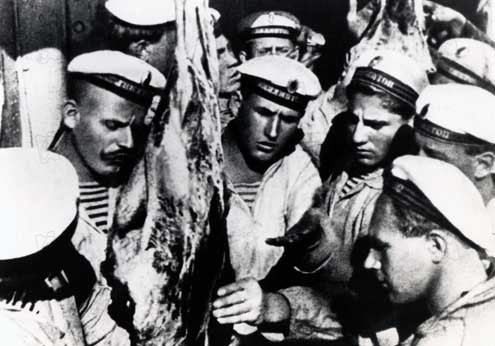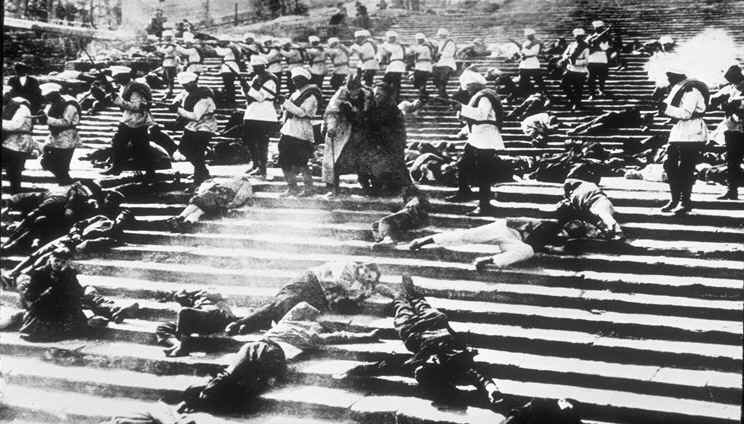It's worth recalling the extent to which the Russian Revolution, which director Sergei Eisenstein served as a Red Army soldier from 1918, inspired an incredible boom of the avant-garde in Russia: in music, visual arts and film, Russia was world-leading in the first half of the 1920s, until the ossification of Soviet public life stifled the arts.
The Battleship Potemkin was Sergei Eisenstein's second full-length feature, after 1924's Strike. At twenty-seven years Eisenstein was considered a prodigy when he filmed The Battleship Potemkin, the troubles with Soviet authorities that would cast a shadow over his masterpiece, October (1927), still ahead of him. Although the film's success at home was less than stellar, it fared better internationally.
Designed as the ultimate revolutionary propaganda film, The Battleship Potemkin is divided into five dramatically distinct parts. In 'Men and Maggots', sailors on the battleship Potemkin of the Black Sea Fleet become angered by the rotten, maggot-infested meat they are asked to eat during the first, failed Russian Revolution of 1905.
In 'Drama on the Deck', the conflict comes to a head as the officers' decision to shoot down those unwilling to eat is confronted by a mutiny led by Grigory Vakulinchuk (Aleksandr Antonov). After a fight, the mutinous sailors take over the ship.
After the fallen Vakulinchuk is mourned over by the people of nearby Odessa in 'A Dead Man Calls for Justice', the revolutionary population is massacred by Tsarist troops and Cossacks on 'The Odessa Steps'. Finally, the Potemkin must face a naval squadron sent to quash the mutiny.
The version I saw was restored by the Deutsche Kinemathek and claims to be as close to the original as possible, unlike previous versions compromised by Stalin-era re-editing. It is distinctive for its soundtrack, a re-recording of Edmund Meisel's original score, and for the colouring of the red flag the Potemkin flies after the successful mutiny. The brilliant red in a black-and-white film is quite striking and I am more than willing to accept this deviation from the original, since it seems very much in the spirit of Eisenstein. There, are, however, some errors in the subtitles: the call to 'smash the dragons!' is a point of particularly hilarity, although thankfully it does not impede efforts to disarm the dragoons.
Seeing The Battleship Potemkin on the big screen I was very much struck by the perfection of the compositions by cinematographer Eduard Tisse and Eisenstein himself. Image after image is perfectly created; this almost leads to a feeling of sensory overload as the modern viewer is too used to the narrative-centred, 'getting out of the actors' way' style of twenty-first-century direction.
The Odessa steps sequence is the film's most famous by far. And it deserves to be: it's perfectly shot and shockingly violent by the standards of the times. But it shouldn't overshadow other scenes. The early confrontation between recalcitrant sailors and officers is particularly tense, as is the climactic showdown between Potemkin and the Tsarist squadron.
Eisenstein films are notable in eschewing the individualism that is endemic in western cinema. So it is with The Battleship Potemkin: although Vakulinchuk is the only named sailor, he is killed in the second of the film's five episodes and remains a cipher, no more than a spokesman for the revolutionary proletariat. No, the protagonist of The Battleship Potemkin is the collective of the mutinous sailors and, in chapters three and four, the revolting populace of Odessa. It is virtually only the villains who actually receive names.
Speaking of villains: as a work of Soviet propaganda, the film of course deals in broad stereotypes. The bad guys walk around in finery and sport monocles; one attempts to turn the people's assembly in Odessa into a pogrom and is beaten to death for his troubles by the people, who of course know their woes cannot be blamed on the Jews. But such a clear distinction between heroes and villains is not necessarily a bad thing; indeed The Battleship Potemkin absolutely could not work if the counter-revolutionaries were treated fairly.
Propaganda, then: but what propaganda! You don't need to be a dirty Red like me to enjoy this film (although it helps): Joseph Goebbels was apparently a jealous admirer of Eisenstein's craft. But you must bring a willingness to accept collective protagonists, the flexibility to adjust to silent film, and sturdy footwear to prevent your socks from being blown off. What are you waiting for? To the cinema, post haste.






No comments:
Post a Comment